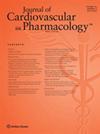Glutathione S-Transferase α4 Alleviates Hyperlipidemia- Induced Vascular Neointimal Hyperplasia in Arteriovenous Grafts via Inhibiting Endoplasmic Reticulum Stress.
IF 2.6
4区 医学
Q2 CARDIAC & CARDIOVASCULAR SYSTEMS
引用次数: 0
Abstract
Neointimal hyperplasia causes the failure of coronary artery bypass grafting (CABG). Our previous studies have found that endothelial dysfunction is one candidate for triggering neointimal hyperplasia, but which factors are involved in this process is unclear. Glutathione S-transferase α4 (GSTA4) play an important role in metabolizing 4-hydroxynonenal (4-HNE), a highly reactive lipid peroxidation product, which causes endothelial dysfunction or death. Here, we investigated the role of GSTA4 in neointima formation after arteriovenous grafts (AVGs) with or without high-fat diet (HFD). Compared with normal diet (ND), HFD caused endothelial dysfunction and increased neointima formation, concomitantly accompanied by downregulated expression of GSTA4 at the mRNA and protein levels. In vitro, overexpression of GSTA4 attenuated 4-HNE-induced endothelial dysfunction and knockdown of GSTA4 aggravated endothelial dysfunction. Furthermore, silencing GSTA4 expression facilitated the activation of 4-HNE induced endoplasmic reticulum stress (ERS) and inhibition of ERS pathway alleviated 4-HNE-induced endothelial dysfunction. Additionally, compared with wild-type (WT) mice, mice with knockout of endothelial-specific GSTA4 (GSTA4 EC KO) exhibited exacerbated vascular endothelial dysfunction and increased neointima formation caused by HFD. Together, these results demonstrate the critical role of GSTA4 in protecting the function of endothelial cells and in alleviating hyperlipidemia-induced vascular neointimal hyperplasia in arteriovenous grafts.谷胱甘肽 S-转移酶 α4通过抑制内质网应激缓解高脂血症诱导的动静脉移植物血管新内膜增生。
新内膜增生是冠状动脉旁路移植术(CABG)失败的原因。我们之前的研究发现,内皮功能障碍是引发新内膜增生的一个候选因素,但这一过程涉及哪些因素尚不清楚。谷胱甘肽 S 转移酶 α4(GSTA4)在代谢高活性脂质过氧化产物 4-hydroxynonenal (4-HNE) 过程中发挥着重要作用,而 4-hydroxynonenal 会导致内皮功能障碍或死亡。在此,我们研究了 GSTA4 在动静脉移植(AVG)后新内膜形成中的作用。与正常饮食(ND)相比,高脂饮食会导致内皮功能障碍和新内膜形成增加,同时伴随着 GSTA4 在 mRNA 和蛋白水平上的表达下调。在体外,过表达 GSTA4 可减轻 4-HNE 诱导的内皮功能障碍,而敲除 GSTA4 则会加重内皮功能障碍。此外,沉默 GSTA4 的表达可促进 4-HNE 诱导的内质网应激(ERS)的激活,而抑制 ERS 通路可缓解 4-HNE 诱导的内皮功能障碍。此外,与野生型(WT)小鼠相比,内皮细胞特异性 GSTA4 基因敲除(GSTA4 EC KO)小鼠表现出 HFD 导致的血管内皮功能障碍加剧和新生内膜形成增加。这些结果共同证明了 GSTA4 在保护内皮细胞功能和缓解高脂血症诱导的动静脉移植物血管新生内膜增生方面的关键作用。
本文章由计算机程序翻译,如有差异,请以英文原文为准。
求助全文
约1分钟内获得全文
求助全文
来源期刊
CiteScore
5.10
自引率
3.30%
发文量
367
审稿时长
1 months
期刊介绍:
Journal of Cardiovascular Pharmacology is a peer reviewed, multidisciplinary journal that publishes original articles and pertinent review articles on basic and clinical aspects of cardiovascular pharmacology. The Journal encourages submission in all aspects of cardiovascular pharmacology/medicine including, but not limited to: stroke, kidney disease, lipid disorders, diabetes, systemic and pulmonary hypertension, cancer angiogenesis, neural and hormonal control of the circulation, sepsis, neurodegenerative diseases with a vascular component, cardiac and vascular remodeling, heart failure, angina, anticoagulants/antiplatelet agents, drugs/agents that affect vascular smooth muscle, and arrhythmias.
Appropriate subjects include new drug development and evaluation, physiological and pharmacological bases of drug action, metabolism, drug interactions and side effects, application of drugs to gain novel insights into physiology or pathological conditions, clinical results with new and established agents, and novel methods. The focus is on pharmacology in its broadest applications, incorporating not only traditional approaches, but new approaches to the development of pharmacological agents and the prevention and treatment of cardiovascular diseases. Please note that JCVP does not publish work based on biological extracts of mixed and uncertain chemical composition or unknown concentration.

 求助内容:
求助内容: 应助结果提醒方式:
应助结果提醒方式:


